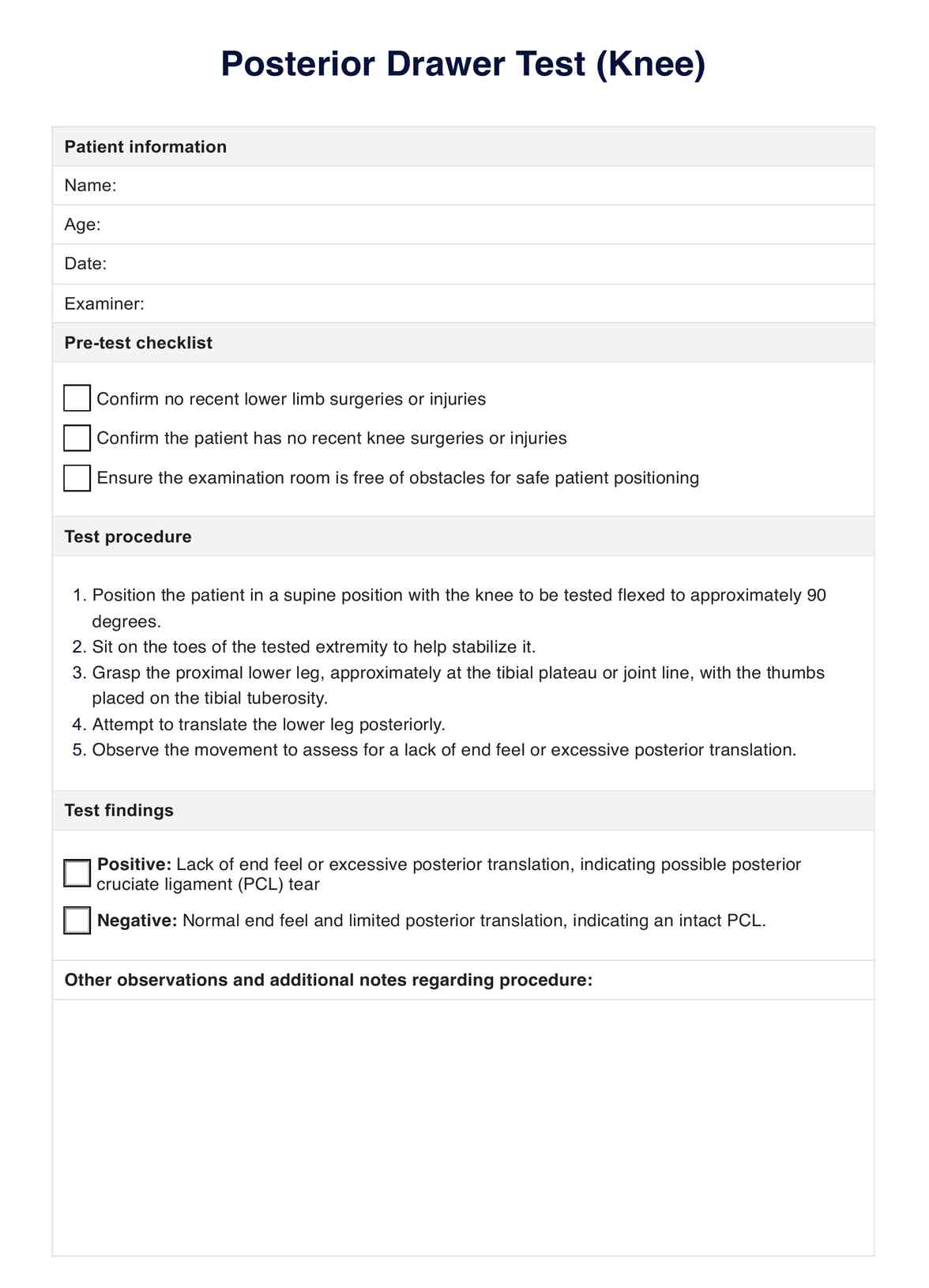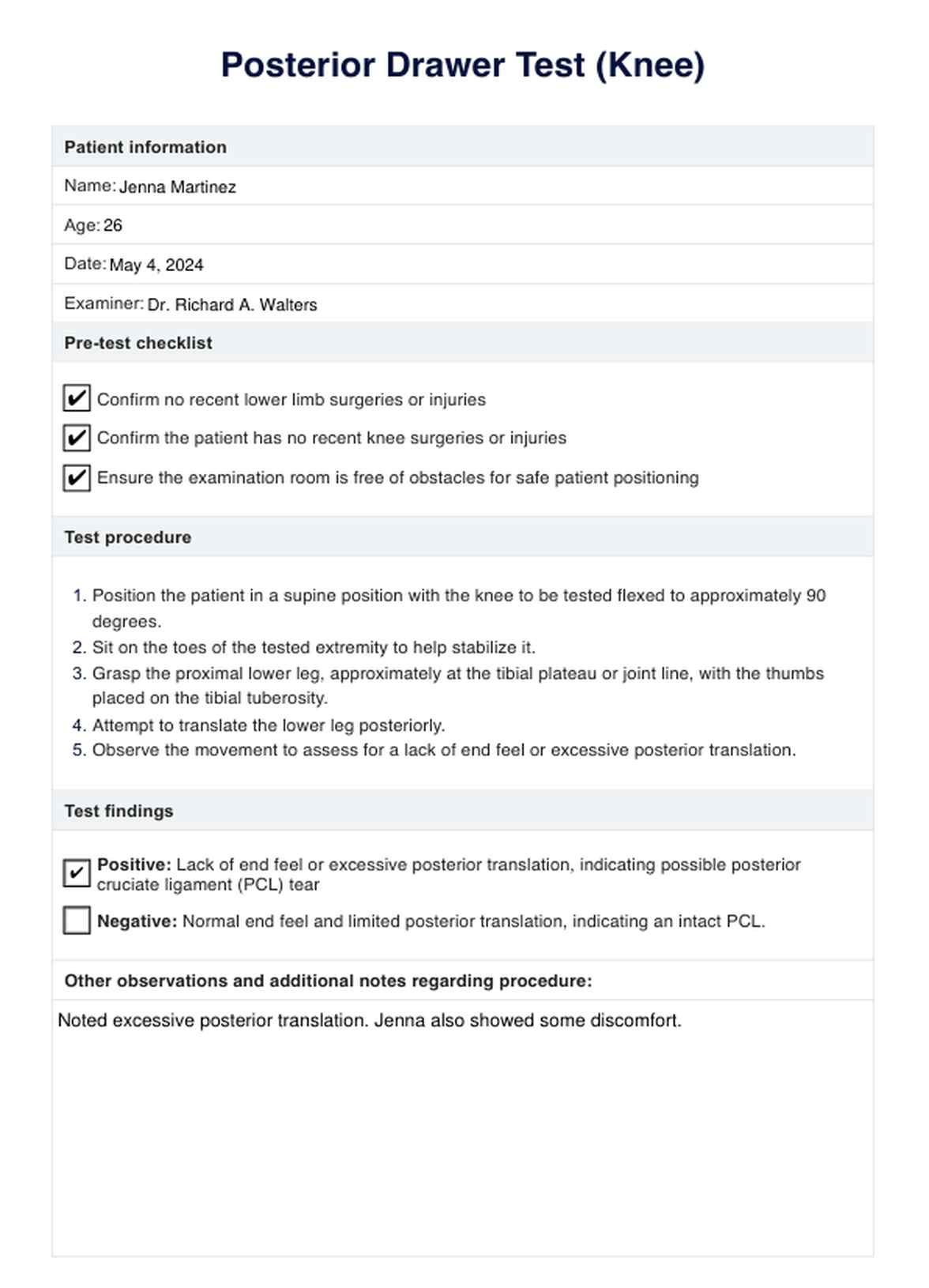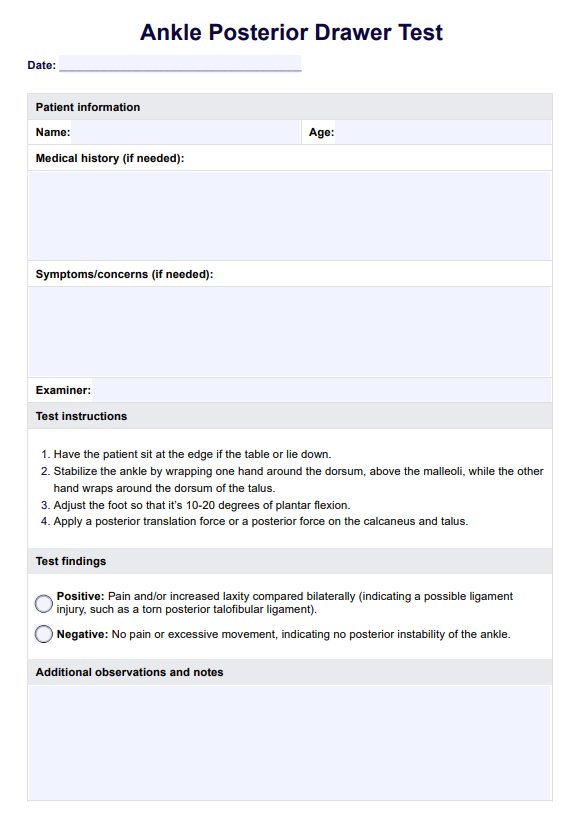Posterior Drawer Test (Knee)
Use our Posterior Drawer Test (Knee) template to assess PCL injuries accurately and enhance clinical documentation. Learn more about PCL injuries here.


What is a posterior cruciate ligament injury?
The posterior cruciate ligament (PCL) is located at the back of the knee and connects the medial femoral condyle of the femur to the posterior aspect of the proximal tibia. A PCL injury refers to a tear or sprain in that ligament.
The PCL is one of four primary ligaments that stabilize the knee joint. It specifically prevents the tibia from moving backward relative to the femur, ensuring knee stability during movement.
PCL injuries are often less common than anterior cruciate ligament (ACL) injuries but can still have significant consequences for knee function and stability. These injuries commonly affect athletes involved in contact sports, individuals who have experienced trauma or accidents, and those who have suffered knee hyperextension injuries.
Symptoms and causes
Posterior cruciate ligament injuries can present with a range of symptoms and are typically caused by sudden trauma or impact to the knee. People who have a PCL injury usually experience several of the following:
- Pain at the back of the knee
- Swelling
- Instability
- Limited range of motion
- Difficulty walking
- Bruising
PCL injuries are typically caused by trauma or forceful impact to the knee, often resulting from activities such as sports or accidents. Common causes include falling on a bent knee, direct impact to the shinbone, or hyperextending the knee. High-speed vehicle collisions or contact sports can also lead to PCL tears when the knee is forcefully bent backward.
Potential problems this may cause
Untreated or severe knee ligament injuries can lead to long-term knee instability, chronic pain, and difficulty with daily activities or sports. Over time, posterior cruciate ligament tears and related issues can contribute to the development of arthritis or damage to other structures within the knee, like the meniscus or cartilage, ultimately compromising knee function and quality of life.
Posterior Drawer Test (Knee) Template
Posterior Drawer Test (Knee) Example
What is the Posterior Drawer Test (Knee)?
The Posterior Drawer Test (Knee) is a clinical examination method used to assess the integrity of the posterior cruciate ligament. This test is crucial for diagnosing potential PCL tears, as it helps identify any abnormal posterior movement of the tibia in relation to the femur. The posterior drawer test is commonly used in orthopedic and sports medicine settings to evaluate knee injuries, especially those resulting from trauma or sports activities.
How is this test conducted?
To conduct the posterior drawer test for the knee, do these steps:
- Place the patient in a supine position with the knee to be tested flexed to approximately 90 degrees.
- Sit on the toes of the tested extremity to keep the knee flexed and stabilized.
- Grasp the proximal lower leg, approximately at the tibial plateau or joint line, with the thumbs placed on the tibial tuberosity.
- Attempt to translate the lower leg posteriorly.
- Observe the movement to assess for a lack of end feel or excessive posterior translation.
How are the results interpreted?
The results of the posterior drawer test can be interpreted as follows:
- Negative: Normal end feel and limited posterior translation, indicating an intact PCL.
- Positive: Lack of end feel or excessive posterior translation, indicating a possible PCL tear.
A positive result typically warrants further imaging studies or specialist consultation to confirm the diagnosis and determine the severity of the injury. Once the diagnosis and confirmed and severity is assessed, you can assess treatment options for the patient, such as RICE or preoperative and postoperative assessment.
How to use our Posterior Drawer Test (Knee) template
Our Posterior Drawer Test (Knee) template provides healthcare professionals with a structured approach to assess posterior cruciate ligament integrity. The template includes key elements for effective and consistent testing, helping to document findings accurately and efficiently.
Step 1: Access this template
Access the template through the Carepatron app or on the website's template collection. It's available for digital use or as a printable document, making it convenient for different clinical settings. You can edit the template and share it with other healthcare professionals on the app, too.
Step 2: Explain the template
Before beginning the test, explain the template's purpose and structure to the patient or assisting staff. This step helps ensure everyone understands the procedure, enhancing patient cooperation and assisting staff in understanding their roles.
Step 3: Prepare for the test
Utilize the pre-test checklist provided in the template to prepare for the procedure. Ensure there are no recent lower limb or knee surgeries or injuries, and confirm that the examination room is clear of obstacles.
Step 4: Conduct the test
Follow the detailed steps in the template to perform the Posterior Drawer Test. Position the patient, stabilize the knee, and attempt to translate the lower leg posteriorly while observing the movement.
Step 5: Document the findings
Use the template to document the test results, noting whether the test is positive or negative and recording any other observations or additional notes.
By using this template, healthcare professionals can ensure a consistent and thorough approach to assessing PCL injuries, leading to improved patient outcomes and clearer documentation.
Treatments for PCL injuries
Not every PCL injury is the same—each one requires an individualized approach, depending on the severity of the injury and the patient's needs. For some, all it takes is rest and some ice. Others may need surgery. Here are some common treatment options for PCL injuries:
- Conservative management: For a mild or moderate acute PCL injury, conservative treatments like rest, ice, compression, and elevation (RICE) can help reduce swelling and pain. Physical therapy may also be recommended to strengthen the surrounding muscles and improve knee stability.
- Knee bracing: In some cases, a knee brace may be recommended to immobilize and protect the knee during the healing process. Bracing helps to reduce the strain on the PCL, allowing it to heal properly.
- Physical therapy: Physical therapy is a crucial part of recovery for PCL injuries. A targeted rehabilitation program can improve strength, flexibility, and range of motion, aiding in a full recovery and helping to prevent future injuries.
- Surgical intervention and post-surgical rehabilitation: For severe PCL injuries or cases where conservative treatments have failed, surgery may be necessary. Surgical options include PCL reconstruction, where a graft is used to replace the damaged ligament, restoring knee stability. After surgery, a comprehensive rehabilitation program guided by a healthcare professional is essential, which involves physical therapy and gradually increasing activity levels.
The best treatment approach depends on the individual case and should always be determined in consultation with a healthcare professional. This ensures that patients receive the most effective care tailored to their specific needs and circumstances.
Commonly asked questions
Two common tests for posterior cruciate ligament (PCL) injuries are the posterior drawer test and the posterior sag sign. Both tests help assess the stability of the posterior cruciate ligament.
The posterior drawer test evaluates the integrity of the posterior cruciate ligament by assessing for excessive posterior movement of the tibia, indicating a potential tear or injury.
A positive posterior drawer test suggests a potential tear or injury to the posterior cruciate ligament, which could lead to knee instability and functional issues.























-template.jpg)
















































































